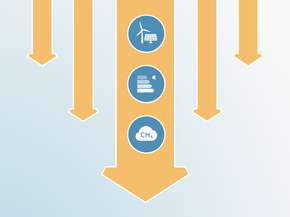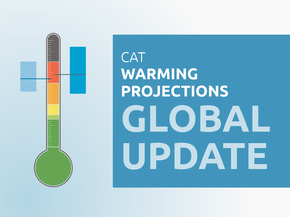Current Policy Projections
Economy-wide
Our analysis shows that India can achieve its NDC target with currently implemented policies, i.e. it would not have to put any other policies in place. Under current policy projections, greenhouse gas emissions (excluding LULUCF) are projected to reach a level of 3.4 GtCO2e in 2020 and 5.0–5.2 GtCO2e in 2030. This is a 64–66% increase in emissions from 2010 levels by 2020 and a more than doubling of 2010 levels by 2030. While this growth is in line with both the 2020 and 2030 intensity pledges, the achievement of India’s targets depends on actual economic growth levels.
India’s total emissions have been growing steadily since 1990. The overall growth slowed down around 2000 as land use changed from being a small source of emissions in the first inventory year—14 MtCO2e in 1994—to a large sink, with removals of 223 MtCO2e in 2000 and 253 MtCO2e in 2010.
Population growth is one of the main drivers of India’s projected GHG emissions. By 2028, India is projected to overtake China as the largest country in terms of population. By 2030, India’s population is projected to grow to ~1.5 billion but the per capita emissions would still be far below the world average in 2013 (World Bank, 2017).
The Indian Government is considering long-term growth strategies over the period 2030–2045 that would result in a decoupling of carbon emissions from economic growth. In 2017, it commissioned three research institutes (the Energy Research Institute, the Observer Research Foundation and the Centre for Study of Science, Technology and Policy) to develop these long term low-carbon growth strategies (Scroll.in, 2017). The results of these studies will be published in 2018.
Energy supply
The power sector accounted for 41% of India’s total emissions (excluding LULUCF) in 2015. Given that the fuel mix is dominated by coal-fired generation which was 75% in 2015 (IEA, 2017a), the emissions intensity of electricity supply in India is relatively high (770 gCO2/kWh in 2015).
On the other hand, per capita electricity demand in India is very low, at around 860 kWh/capita in 2015 (IEA, 2018). In June 2014, the Government of India announced its commitment to achieving a reliable electricity supply for all by 2019 (Forum of Regulators, 2014). In that year, 19% of the population—244 million people—still had no access to electricity (IEA, 2016). With steady population and economic growth, India is likely to have the fastest-growing electricity market of any of the world’s biggest economies (IEEFA, 2015). In our projections, we assume a growth of electricity demand of 5.9% a year, as projected in the IEA’s World Energy Outlook (IEA, 2017a).
The original targets of the ”National Solar Mission”, one of India’s major renewable energy-related policies launched in 2010, were 10 GW of solar power capacity by 2017 and 20 GW by 2022 (MNRE, 2010). As of March 2017, India had installed 12.2 W of utility scale solar PV capacity (Bridge to India, 2017). The National Solar Mission was scaled up in August 2015 with a target of increasing solar capacity to 100 GW installed capacity by 2022 as well as higher targets for other renewable energy sources: 60 GW wind, 10 GW biomass and 5 GW small-scale hydro (MNRE, 2015).
This cumulative target of 175 GW renewable energy capacity by 2022 would lead to a share of renewable generation capacity of 40% (42% non-fossil capacity). India would therefore be able to reach its NDC target of 40% non-fossil generation capacity eight years early—without relying on nuclear power. By 2030, non-fossil generation capacity will increase to 47% by 2030, corresponding to a share of 32% non-fossil power generation.
Between 2015 and 2030 under current policies, we estimate the average annual growth rate for solar and wind power generation at around 18%—three times the growth rate of overall electricity production. During the same period, under our current policy pathway, we project capacity additions of ~300 GW for solar and wind power, and ~220 GW for coal power.
This trend is also in line with BP’s Energy Outlook 2018 which suggests that second to China, India will lead the global growth of renewables, representing 14% of global energy demand by 2040 (BP Energy Economics, 2018).
Wind power is supported via a Generation Based Incentive, while state-level feed-in tariffs apply for all renewables. Renewable Energy Certificates (RECs) are in place that promote renewable energy and facilitate Renewable Purchase Obligations (RPOs), which legally mandate a percentage of electricity (8% by 2019) to be produced from renewable energy sources. Every new coal-fired power plant should be accompanied by the installation of renewable power plants with a total capacity of at least 10% of the corresponding coal-fired power plant (IEEFA, 2015; Kenning, 2015).
Since 2010, the Indian Government has doubled the coal tax—now called the Clean Environment Cess— three times, reaching 400 rupees per tonne of coal produced and imported in the 2016–2017 budget. The revenues from the coal tax feed into the National Clean Environment Fund, which provides finance to renewable energy projects.
Although committed to diversifying power supply and supporting renewable energy, India aims to double its domestic coal production to 1.5 billion tonnes by 2020, and reduce its dependency on coal imports (IEEFA, 2015). Under current policies, we project India’s coal-fired power capacity to more than double in the period 2015–2030. However, the Energy and Resources Institute (TERI) assessed that no new coal based capacity may be needed before 2026 (The Energy and Resources Institute, 2017). A recent report by India’s national coal mining company Coal India, also suggests that decreasing costs of solar and storage will have a “significant impact” on the coal industry. In the long term, they anticipate a substantial decrease in demand for coal and an eventual displacement of coal by renewables as a result of climate change and climate finance (Coal India, 2018; Gordon-Harper, 2018).
Nonetheless, there is still substantial uncertainty about the future of coal power capacity in India. As a government think tank (NITI Aayog, 2017a, 2017b) has pointed out in two publications, both the government’s Draft National Energy Policy and the Three Year Action Agenda (2017–18 to 2019–20) include recommendations to increase domestic production and distribution of coal, oil and gas. While the stated aim of this is to enhance India’s energy security, it may stimulate additional fossil-based energy demand, leading to higher GHG emissions. Were all of the 43 GW of coal-fired capacity planned as of July 2017 to be built, India would face greater risks of stranded assets in the power sector (EndCoal, 2017).
In December 2016, the Central Electric Authority (CEA) published the Draft Electricity Plan, which provides electricity demand forecasts for the period 2017–2027 and calculates installed capacities from conventional and renewable energy sources needed to meet that demand (Central Electricity Authority, 2016). To finalise the Draft Plan, the CEA is undertaking a consultation process.
The Draft Plan incorporates the impact of demand-side management as well as numerous energy efficiency and conservation measures that substantially reduce electricity demand. The study reveals that no new coal-fired generation capacity is required during the years 2017–2022. However, it assumes that additional coal-based capacity of 44 GW is needed in the period 2022–2027 to meet increasing electricity demand, which can be supplied by the coal-fired plants already under construction, and likely to be commissioned by 2022. This means that the 178 GW of coal-fired generation capacity in the permitting pipeline is likely to be suspended until at least 2027 (Mathiesen, 2016). Based on the Draft Electricity Plan, we calculate that India will significantly reduce its emissions and, by 2030, its emissions intensity will be 135–140% above 2005 levels, overachieving its NDC target.
The Draft Electricity plan also assumes that no additional gas-fired power plants will be deployed after 2022 as the availability of gas is uncertain in India. Our estimates for the Draft Electricity Plan result in power sector emissions level of 1.19 and 1.14 GtCO2e in 2022 and 2027, respectively, which is slightly higher than the figures calculated by the Draft Electricity Plan for 2022 and 2027, respectively (Central Electricity Authority, 2016). This difference is due to the fact that the Draft Plan uses lower CO2 emission factors while the CAT uses higher emission factors based on WEO 2017.
The Draft National Energy Policy published in June 2017 by a government think tank, the National Institute for Transforming India (NITI) Aayog[1] contains projections for the energy sector in India up to 2040. It is built around the main objective of reducing energy poverty in India, increasing energy security and providing energy access to all its citizens at affordable prices.
It forecasts the share of renewable energy capacity to move above 60% by 2040 and the electricity generation from solar and wind in electricity mix to increase to 14–8% and 9–11%, respectively (NITI Aayog, 2017a). The CAT assessment of India’s Draft Electricity Plan projects a share of 13% and 10% respectively for solar and wind in 2030. In this respect, the Draft National Energy Policy is in line with the projections from the Draft Electricity Plan. The Draft Policy forecasts a primary energy supply growth to 2.7–3.2 times of 2012 levels by 2040 and an increasing share of renewable energy in the primary energy mix to 7–10%, up from 3% in 2012 (NITI Aayog, 2017a).
To enhance energy security, the plan suggests that India needs to decrease its dependency on overseas energy supply by ramping up domestic exploration and production of coal, as well as refining and distribution of oil and gas. The Draft Policy projects India’s primary energy mix, which includes energy consumption in the power sector, as well as other sectors such as industry and transport. The share of coal in India’s primary energy supply falls in relative terms to 44–50% in 2040 from 58% in 2015, whereas in absolute terms the coal consumption nearly doubles according to this document. This increase in domestic production could lead to an increase in emissions if it stimulates additional demand rather than simply displacing imports. An expansion of domestic fossil infrastructure may also lead to lock-in of fossil infrastructure in the coming decades, making it difficult for India to decarbonise energy demand in the long term.
In our CAT assessment, we did not quantify the Draft National Energy Policy since it presents a vision for India’s energy sector towards 2040 and does not suggest concrete measures for achieving the underlying objectives. The Plan is considered a guidance document for the government to plan their actions towards becoming more energy independent and sustainable.
The three year Action Agenda (2017-18 to 2019-20) published by NITI Aayog in August 2017 also advocates for reduced reliance on imports of coal, oil and gas (NITI Aayog, 2017b). At the same time, the plan appears to confirm all of India’s major existing energy policies, mentioning measures to achieve the 2022 renewable energy targets and reaffirming various energy efficiency measures. Similar to the Draft National Energy Policy, the Action Agenda also suggests an increase in domestic production of fossil fuels. This increased production may impact India’s NDC targets if it stimulates additional fossil-based energy demand or affects the implementation of the renewable energy and energy efficiency measures as stated above.
[1] NITI Aayog is a Government of India’s policy think-tank. The stated aim for NITI Aayog's creation is to foster involvement and participation in the economic policy-making process by the State Governments of India. Given its role, the proposed vision for the energy sector holds great importance for national climate policy making.
Industry
The main instrument to increase energy efficiency in industry is the Perform, Achieve and Trade (PAT) Mechanism, which is implemented under the 'National Mission on Enhanced Energy Efficiency'. PAT resembles an emissions trading scheme (ETS) and has been in place since 2012. The scheme is currently in its second phase (2016–2019). PAT differs from traditional cap-and-trade systems as it sets intensity-based energy targets. The current phase covers 621 facilities from 11 different sectors (including rail, electricity distribution, and refineries), and the target is to achieve on average energy savings of 8.9 Mtoe (373 PJ) from the participating facilities in 2019 below the 2014–15 baseline level (Government of India, 2016). Individual targets are calculated for each installation. Installations that exceed their targets can sell Energy Saving Certificates to installations that did not meet their target (EDF, CDC Climat Research, & IETA, 2015).
Transport
India’s first light vehicle fuel efficiency standards came into force in April 2017, setting efficiency targets for new vehicles that weigh under 3,500 kg with no more than nine seats (The International Council on Clean Transportation, 2014; Transportpolicy.net, 2017). The efficiency targets start at the equivalent of 130 gCO2/km in 2017 and fall to 113 gCO2/km in 2022 (Transportpolicy.net, 2017). The standards are based on the average weight of the fleet that manufacturers will sell in a year. The Ministry of Road Transport and Highways (MORTH) is responsible for implementing the standards under the regulations of Bureau of Energy Efficiency (BEE). Currently there are no CO2 emission standards for light commercial vehicles.
In 2013, the Indian Government set up the National Electric Mission Mobility Plan (NEMMP) 2020 (Government of India, 2015a). As part of the Mission, the Department of Heavy Industry launched the Faster Adoption and Manufacturing of (Hybrid &) Electric Vehicles (FAME India) scheme. The scheme aims to support the development of the hybrid/electric vehicle market and targets a deployment of 6–7 million vehicles per year by 2020 (Government of India, 2015a). Indian Power Minister Piyush Goyal announced a target of selling only electric vehicles by 2030, which corresponds with EV sales of over 10 million per year by 2030. In response to this, the state-owned Energy Efficiency Services (EESL) announced its plans to replace 500,000 government cars with electric cars. The realisation of this plan, however, has been hindered in part by the fact that India’s Electricity Act only allows Indian power distribution companies, not private or government entities, to sell electricity, i.e. set up charging stations (Ganguly, 2018). Various proposals are under consideration but the government has yet to embed its vision for electric vehicles in 2030 in regulation.
Forestry
The Indian Ministry of Environment, Forest and Climate Change has developed a new draft National Forest Policy 2018 to replace the existing, 30-year old policy (Government of India, 2018). The draft calls for a minimum of one-third of India’s total geographical area to be under forest or tree cover and supports the NDC target of creating an additional (cumulative) carbon sink of 2.5–3 GtCO2e by 2030. The policy is set to guide forest management in India for the next 25 to 30 years. Corresponding regulation and rules will be amended or developed going forward.
Further analysis
Latest publications
Stay informed
Subscribe to our newsletter




